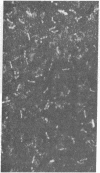Abstract
Electron microscope images of negatively stained fibrinogen are predominantly asymmetric rods 450 A in length and about 60 A in width. The molecules appear to have considerable flexibility, and mass distribution along the major axis is not uniquely distinguished despite apparent beading in some particles. Scanning transmission electron microscopy of unstained fibrinogen again demonstrates that a majority of molecules are rodlike. The results differ from those obtained by negative staining in that a substantial fraction of images are trinodular with striking resemblance to those obtained by C. E. Hall and H. S. Slayter [J. Biophys. Biochem. Cytol. (1959) 5, 11--16] using the mica replica technique. The above results were obtained on glow-discharged carbon substrate films by a simple low-concentration, long-attachment-time modification of standard deposition methods that is diffusion controlled and depends on concentration and time but is independent of pH, buffer, and other staining conditions. Evidence is presented that standard attachment procedures result in artifactual images. Any models of fibrinogen in solution consequently must encompass properties that permit its visualization as an asymmetetric rod by electron microscopy as first suggested by Hall and Slayter 20 years ago.
Full text
PDF




Images in this article
Selected References
These references are in PubMed. This may not be the complete list of references from this article.
- Gorman R. R., Stoner G. E., Catlin A. The adsorption of fibrinogen. An electron microscope study. J Phys Chem. 1971 Jul 8;75(14):2103–2107. doi: 10.1021/j100683a006. [DOI] [PubMed] [Google Scholar]
- HALL C. E., SLAYTER H. S. The fibrinogen molecule: its size, shape, and mode of polymerization. J Biophys Biochem Cytol. 1959 Jan 25;5(1):11–16. doi: 10.1083/jcb.5.1.11. [DOI] [PMC free article] [PubMed] [Google Scholar]
- Karges H. E., Kühn K. The cross striation pattern of the fibrin fibril. Eur J Biochem. 1970 May 1;14(1):94–97. doi: 10.1111/j.1432-1033.1970.tb00265.x. [DOI] [PubMed] [Google Scholar]
- Kay D., Cuddigan B. J. The fine structure of fibrin. Br J Haematol. 1967 May;13(3):341–347. doi: 10.1111/j.1365-2141.1967.tb08749.x. [DOI] [PubMed] [Google Scholar]
- Krakow W., Endres G. F., Siegel B. M., Scheraga H. A. An electron microscopic investigation of the polymerization of bovine fibrin monomer. J Mol Biol. 1972 Oct 28;71(1):95–103. doi: 10.1016/0022-2836(72)90403-2. [DOI] [PubMed] [Google Scholar]
- Pouit L., Marcille G., Suscillon M., Hollard D. Etude en microscopie électronique de différentes etapes de la fibrinoformation. Thromb Diath Haemorrh. 1972 Jul 31;27(3):559–572. [PubMed] [Google Scholar]









